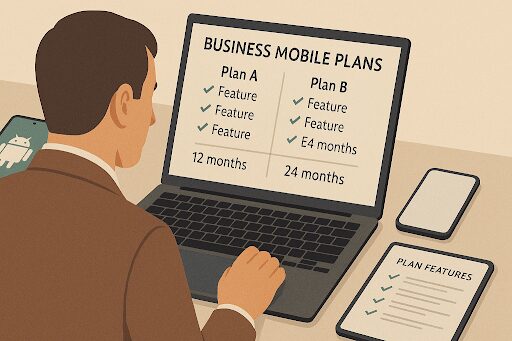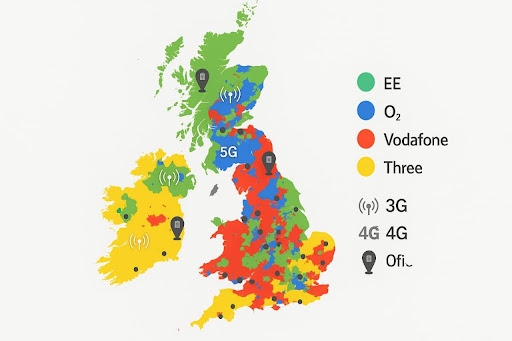When starting a new business, you will have to go through the daunting process of selecting the right mobile plan.
There are quite a few options available to select from and you will not have an idea on which one to pick.
With different networks, devices, tariffs, and add-ons, you should still pick the right plan that caters to your business needs.
Read this guide and we will help you understand how to do it.
Assess Your Usage

The first step is understanding your business’s mobile usage patterns. Consider the following questions:
- How many employees need mobile devices? Determine if you want plans for just key people or the entire workforce.
- How much monthly data does each employee need – 500MB, 1GB, unlimited? Estimate usage based on current employees or industry benchmarks.
- How many voice minutes and text messages will be required? This may vary significantly by employee.
- Is international calling needed? Identify which countries you routinely call.
Document usage across all activities like emailing, web browsing, apps, navigation, streaming and conferencing. Underestimating data and voice needs is a common mistake that results in costly overage fees or throttled data speeds. Be realistic about projected growth too.
Compare Network Coverage

The carrier you choose needs to provide adequate service to all your office and operational locations.
Review coverage maps for major networks like EE, O2, Three and Vodafone across 3G, 4G and 5G. Identify any geographic gaps at your sites which could hamper daily operations.
Also research which networks offer the fastest, most consistent data speeds in your operational areas.
Evaluate Business Mobile Plans
Once you’ve estimated usage and researched networks, start comparing business mobile plans. Here are key factors to look at:
Shared vs Individual Allowances: With shared data allowances, unused data rolls over between employees each month. Individual plans don’t roll over but may enable more customization.
Plan Allowances: Look for monthly allowances that cover your voice minutes, texts and data needs. Also see if data speeds are reduced after reaching certain thresholds.

Network Perks: Business plans may include network benefits like free calls between colleagues, shared minutes, international options and advanced security/control features.
Contract Length: Options range from 30-day prepay plans to 12-24 month contracts. Consider what commitments your business can make.
Device Subsidization: Many contract plans subsidize device purchase in exchange for a service commitment. This reduces upfront costs.
Roaming: If employees travel frequently, opt for a plan that includes European or global roaming to avoid shocking bills.
Other Add-Ons: Assess needs for international calling, application subscriptions, mobile device management tools or cloud storage. The costs can add up.
Cost Savings: Ask providers about potential multi-line and loyalty discounts. Buying through a vendor partner may also yield exclusive savings.
By modeling different usage scenarios across the employee base with a few leading plans, you can narrow down the best options.
Be sure to read all policies around carryover data, video streaming quality, roaming restrictions, plan changes/cancellations and more. It’s also wise to leave some room in your selected monthly allowances to accommodate unexpected overages each month.
Sign Up and Deploy New Plans
Once you’ve selected the right carrier and plan – it’s time for activation. Share key account details like the account owner, billing address and contract term with any necessary finance staff. Also coordinate internally around new phone ordering, shipping and set-up.
Hold training sessions with employees to educate them on their new device capabilities, data allowances and billing procedures.
Also set policies around issues like excessive personal usage. Implement mobile device management where feasible to further control data usage and apps.
Consider a testing period to trial the new plans before fully transitioning your entire workforce.

Consider the Mobile Device Itself
Aside from selecting the right carrier and service plan, you’ll need mobile devices suited for your workforce. The phones and tablets themselves impact connectivity and productivity in various ways:
Operating System – Most businesses opt for either iOS or Android devices that align with in-house app development and software ecosystems. Evaluate from technical and end user experience perspectives. Consider who will provide device support as well.
Durability – Choose ruggedized mobile devices if employees work outdoors or in challenging environments. Look for water, dust and drop-resistant models along with glove-friendly screens for industrial settings. Consumer phones break easily.
Battery Life – Employees who travel or who are scarcely desk-bound will require all-day battery life. Compare norms for standby and active use across leading devices – seeking over 10 hours of screen time ideally. Have spare charging cases available too.
Display Size – Determine ideal screen sizes based on typical usage – accounting for portability but enabling ample viewing areas for productivity apps, web access and communications. Look for clear displays for all lighting conditions.
Features – Frontline teams may specifically require equipment like barcode scanners while executives desire cutting-edge cameras and memory. Only pay for the mobile capabilities each role truly needs day to day.
The mobile network you choose then needs to support the devices selected based on LTE bands and technical specifications like Bluetooth versions. Invest wisely in reliable models suited for your on-the-go personnel.
Monitor Usage and Cost Trends
Leverage the administrative dashboard of your carrier account to actively monitor usage, adoption and spend across your new business mobile plan. Address any overages promptly through internal policy changes – before they yield big bills.
You may also need to tweak monthly allowances across lines if initial assessments were off. Contact carrier reps to explore more suitable plans as needs evolve.
A thorough selection process is critical for securing business mobile plans that cost-effectively meet your connectivity requirements. Avoid plans that provide insufficient or excessive allowances.
Analyze usage rigorously and leave room for both seasonal fluctuations and multi-year growth. With due diligence upfront and ongoing oversight, your mobile deployment will be poised for success.





































